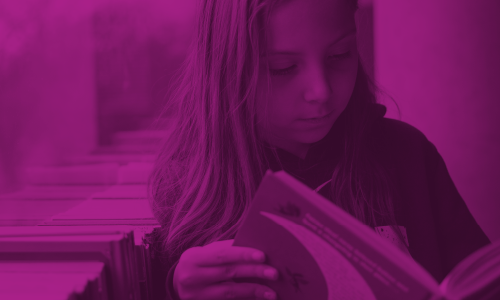
When my youngest stepson chose to come live with me and my husband, he had just turned 16. He’d attended more than 12 schools in the previous six years and had lived in three different states. He had been held back and was repeating his freshman year in high school. All those things we knew. What we didn’t know was that he could barely read. My stepson clearly needed reading interventions.
His English teacher called us in to break the news. The first thought that popped into my head was, “How? How could a kid make it this far and not know how to read?”
I was fully aware that NAEP reading scores were consistently low for grades 4 and 8, but for some reason, it never clicked that those low scores weren’t just related to lack of understanding. I realized that they were very likely related to the fact that some students couldn’t even read the passages, much less answer the comprehension questions about them. According to a 2017 study, issues with fluency were present in 80% of a sample of adolescent students who had difficulty learning to read. My stepson’s frequent moves from school to school only made things worse.
The root of the problem
As a former elementary reading specialist, I knew how to teach young students to read. But I had no experience teaching older students. My stepson, who read at a third-grade level, desperately needed to catch up to his peers, and I didn’t have a clue about how to help him. When I asked his teacher for guidance, he was very honest and admitted that his professional training had never focused on how to help high schoolers needing support with reading fluency; it had been more about furthering comprehension. And since he was new to teaching, he hadn’t run across a situation like this one before. Thus began the journey to find ways to support my child and ensure he would be career and college ready by the time he graduated.
We know that reading skills improve over time, as long as students meet some essential milestones. It all starts with early literacy skills at home. Families introduce unfamiliar words and concepts via oral language while conversing with their children. Children are exposed to environmental print, like stop signs or the large golden arches of McDonald’s, and they begin to understand those stand for words and have meaning. Research also shows that reading to children increases their reading achievement, so children who get to experience being read to at an early age are at an advantage.
Begin by prioritizing fluency without neglecting comprehension.
When children start school, they should be taught the foundational skills of reading, such as phonemic awareness and phonics. These are the building blocks that help shift their trajectory from attaining literacy skills to developing reading skills. As they progress through the grades, the demands on their reading abilities should increase as they navigate more challenging texts that come in a variety of formats. According to a 2006 report from ACT, the ability to process complex texts is the largest factor in helping students become college- and career-ready. By the end of high school, students should be able to read and comprehend texts that mirror what they will see in college or their field of interest.
But what happens if one of the required steps is skipped? That’s all too common, and that’s exactly what happened to my stepson.
If you’re a middle or high school teacher, where do you even begin when you want to help students who need extra support in reading? The bad news is that there is no magic formula; one approach may work for some students and not others. The good news is that teachers are usually really good at determining the areas giving their students the most trouble, even if those weren’t part of their professional training. I encourage you to begin by prioritizing fluency without neglecting comprehension.
Begin by prioritizing fluency
Let’s focus on reading fluency first, as that is often the main problem. Here are two specific approaches I recommend for reading interventions for fluency.
1. Use repeated reading
Have students read a grade-level text multiple times. This is called repeated reading, and you can learn more about it in the Reading Rockets article by Timothy Shanahan titled “Everything you wanted to know about repeated reading.”Our “Fluency protocol” can also help you plan a whole week’s worth of lessons focused on a single text.
Repeated reading can take many forms. You may read a text for your students first. You could also use echo reading (where students repeat after you), choral reading (where you all read a passage in unison), partner reading, and independent rereading. Whatever your approach, exposing students to the same text multiple times allows them to really dig deeply into ways to navigate it, which will help them improve comprehension.
Here’s a challenging sentence freshmen may encounter from Frederick Douglass’s speech “What to the slave is the Fourth of July?”: “O! had I the ability, and could I reach the nation’s ear, I would, today, pour out a fiery stream of biting ridicule, blasting reproach, withering sarcasm, and stern rebuke.”
The first time you model a text like this, some of the words may be unfamiliar to your students, such as “ridicule,” “reproach,” “withering,” and “rebuke.” “Nation’s ear” may also cause confusion. The second reading might be an echo reading: you read one sentence aloud and your students repeat it. At this point, every student will have heard the text modeled twice by you, with expression and correct pronunciation, which will help them when they read independently.
If any students are still working on their fluency after their independent reading, make a recording of you reading the passage and allow your students to use it whenever they feel they need to. Note that if a text is very long, this approach should be used with chunks of text rather than the entire text, to maximize effectiveness.
2. Make time for word analysis and syllabication
It’s important to help students figure out the meaning of challenging words. Let’s revisit the Douglass speech. “Ridicule,” “reproach,” “withering,” “rebuke,” and “nation’s ear” may all be hard for them to understand. I encourage you to explore context clues with your students—and to also talk about roots and affixes.
When discussing context, ask your class, “Is there any context in the sentence or the surrounding paragraph that would provide clues as to a word’s meaning?” Your students are likely to understand the word “sarcasm,” for example. What might that suggest about “ridicule,” “reproach,” and “rebuke”?
Zeroing in on roots and affixes can be helpful, too. Let’s look closely at “rebuke.” Ninth-grade students have seen the prefix re- many times over the years. Talk to them about its meaning. Then talk to them about how it changes a word it is added to. Next, look at “buke.” This is not a common root word, so it’s unlikely your students will know it means “mouth” or “mouthful” in Latin. With a little more guidance from you, your students can now piece together that “rebuke” means “a strongly worded statement back to someone.”
Another way to navigate challenging words is to chop up long words into syllables. Some students see long words and just skip them. Have them divide the word into syllables instead. Make sure they understand that each syllable has a vowel sound in it. For example, earlier in the speech, Douglass uses the word “immeasurable” to describe the existing inequality between Black people and white people at the time. When “immeasurable” becomes “im-mea-sur-able,” it can be much easier to read.
Don’t forget comprehension
As your students’ fluency improves, so should their comprehension; they will no longer have to focus on the word level and can concentrate on the information or message of the text they are reading. There are many reading interventionsto help students improve comprehension. I encourage you to focus on grade-level texts and practice chunking texts.
1. Use grade-level texts
Students must be exposed to texts appropriate for their grade level. Offering them only texts below their grade level doesn’t give them enough opportunities to strengthen their reading ability. An abundance of research has shown that students make more gains in reading when they interact with complex texts appropriate to their grade level.
Texts below grade level can serve to scaffold up to grade-level texts. Those lower-level passages that are linked to the grade-level text you’re studying as a class can introduce students to background knowledge on the topic as well as new vocabulary, building a stair step of knowledge that will then help them access the grade-level text. See “Building background knowledge through reading: Rethinking text sets” by Sarah Lupo et al. for more on this.
The Douglass speech I mentioned earlier is a prime example of this. It’s often taught in high school, but exactly when varies. It’s likely ninth-grade students will need more scaffolding than seniors, for example.
Students needing extra support, either because they’re early in their high school career or simply need more support with reading, could start with a biography about Douglass with a lower reading level; it explains one of the reasons he is so passionate during his speech. You could also give your class a set of questions about Douglass and ask them to use their digital literacy skills to find the answers. In heterogenous groups, the students who did the research could share their findings while the more confident readers could do the first out-loud reading of the text. Once you observe all students have captured the important ideas that will help them understand the grade-level text, they can all focus on the speech itself.
2. Chunk texts
With my stepson, I noticed that he gave up on longer texts before he even tried them. All those pages and all those words were extremely intimidating for him. So, we chunked them. I would read aloud one paragraph and then he would summarize that paragraph in one sentence, which we wrote down. When I felt he was ready, we would chunk two paragraphs at a time and he would write down the summary for those. At the end of a study session, he would read me the summary sentences and I would ask him questions about the text.
In the beginning, I did all the reading and he followed along in his book. But by the time we got to Night by Elie Wiesel, he was able to read more of the text himself. Was it perfect? Not at all, but it was a grade-level text, and he was productively struggling. We did this for months on end with every text he interacted with.
Keep exploring
The approaches outlined here are not a comprehensive list of reading interventions; rather, they are examples of what helped my stepson. There were things his teacher and I tried that didn’t work well for him, even though they were evidence-based.
The solution to getting students who fell through the cracks back on track isn’t going to be an easy one. But not finding a solution is unacceptable. I’m happy to report that by the end of the school year, my stepson was reading at a seventh-grade level, which means he gained four years during that one school year. He also went on to pass all of his state summative exams.
Students deserve to get the support they need to be prepared for life after high school. Scaffolds must be in place to ensure that reading is, indeed, a lifelong endeavor.




